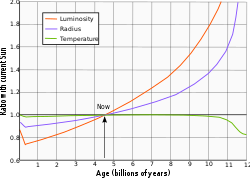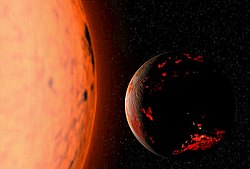solar luminosity (L☉) is a unit of radiant flux (power emitted in the form of photons) conventionally used by astronomers to measure the luminosity of...
6 KB (641 words) - 21:12, 17 March 2025
units, luminosity is measured in joules per second, or watts. In astronomy, values for luminosity are often given in the terms of the luminosity of the...
24 KB (3,002 words) - 14:24, 29 March 2025
Sun (redirect from Solar diameter)
930 °F), resulting in a 48% increase in luminosity from 0.677 solar luminosities to its present-day 1.0 solar luminosity. This occurs because the helium atoms...
173 KB (19,375 words) - 22:10, 1 June 2025
Main sequence (section Luminosity-color variation)
solar masses. This is listed in the table as 1.26 times the solar luminosity. At metallicity Z = 0.01 the luminosity is 1.34 times solar luminosity....
61 KB (6,825 words) - 06:23, 3 May 2025
Future of Earth (section Solar evolution)
gravitational interactions with other objects in the Solar System, and a steady increase in the Sun's luminosity. An uncertain factor is the influence of human...
99 KB (11,034 words) - 23:18, 25 May 2025
of solar luminosity revealed a direct relationship between the solar cycle and luminosity with a peak-to-peak amplitude of about 0.1%. Luminosity decreases...
90 KB (10,111 words) - 06:00, 20 May 2025
Parker Solar Probe (as close as 9 R☉) Astronomical unit Earth radius Jupiter radius List of largest stars Orders of magnitude (length) Solar luminosity Solar...
14 KB (1,236 words) - 12:15, 31 March 2025
RealClearScience". Realclearscience. Retrieved November 22, 2020. Calculated as: Solar luminosity × 10^(0.4 × (Sun absolute magnitude - 3C 273 absolute magnitude)) =...
55 KB (2,726 words) - 06:27, 2 June 2025
speculating on possible relationships between sunspots and solar luminosity in the 17th century. Luminosity decreases caused by sunspots (generally < - 0.3%) are...
48 KB (5,256 words) - 11:03, 24 May 2025
sheets. A mechanism that may account for periodic fluctuations in solar luminosity has also been proposed as an explanation. Diffusion waves occurring...
22 KB (2,557 words) - 07:14, 18 March 2025
Absolute magnitude (redirect from Absolute luminosity)
solar luminosity corresponds closely to Mbol = 4.74, a value that was commonly adopted by astronomers before the 2015 IAU resolution. The luminosity of...
50 KB (5,802 words) - 20:36, 30 May 2025
current power. Under the present atmospheric composition, this past solar luminosity would have been insufficient to prevent water from uniformly freezing...
72 KB (7,647 words) - 01:50, 28 January 2025
600 K (2,330 °C; 4,220 °F)) than now, and its luminosity much higher—up to 2,700 current solar luminosities. For part of its red-giant life, the Sun will...
113 KB (13,512 words) - 23:15, 21 May 2025
Faint young Sun paradox (section Solar evolution)
considerably. At the surface of the Sun, more fusion power means a higher solar luminosity (via slight increases in temperature and radius), which is termed radiative...
30 KB (3,666 words) - 15:25, 18 April 2025
126 parsecs from the Sun. It has a mass of 0.9 solar masses and a luminosity of 1.5 solar luminosity. It is only somewhere between 0.5-1.0 million years...
7 KB (638 words) - 04:07, 30 May 2025
mass of 1.05 solar masses, a radius of 1.157 solar radii, a temperature of 5829 Kelvin and a luminosity of 1.39 times the solar luminosity. Kepler-385...
7 KB (512 words) - 19:24, 14 May 2025
Star (section Luminosity)
as will the star's temperature and luminosity. The Sun, for example, is estimated to have increased in luminosity by about 40% since it reached the main...
147 KB (16,423 words) - 20:22, 31 May 2025
through either power law or blackbody fits. The luminosity thus obtained is known as the bolometric luminosity.[citation needed] Masses are often calculated...
4 KB (456 words) - 17:27, 27 April 2025
be 4.6 billion years old, with the correct metallicity and a 0.1% solar luminosity variation. Stars with an age of 4.6 billion years are at the most stable...
38 KB (3,392 words) - 21:28, 30 March 2025
thousand times the solar radius, and a luminosity of over 200,000 times the solar luminosity. If placed at the center of the Solar System, its photosphere...
16 KB (1,669 words) - 19:28, 10 January 2025
Stefan–Boltzmann law, luminosity increases with the fourth power of temperature, causing even a small loss of heat to produce a large luminosity contrast.) In...
3 KB (320 words) - 19:15, 5 May 2025
The Eddington luminosity, also referred to as the Eddington limit, is the maximum luminosity a body (such as a star) can achieve when there is balance...
30 KB (3,261 words) - 22:05, 16 May 2025
Seyfert galaxy (section Eddington luminosity)
wavelengths, it becomes clear that the luminosity of their cores is of comparable intensity to the luminosity of whole galaxies the size of the Milky...
48 KB (5,701 words) - 05:14, 23 May 2025
condensing to form a white dwarf. It has 55–60% of solar mass, is 41 to 148 times solar luminosity (L☉), and has an effective temperature of 123,000 K...
15 KB (1,554 words) - 00:47, 25 May 2025
experience a runaway greenhouse effect "in about 2 billion years as solar luminosity increases". While the term was first coined by Caltech scientist Andrew...
39 KB (4,811 words) - 23:52, 19 April 2025
a O9.5 II blue giant. Together, the system has a combined ~250,000 solar luminosity. Mintaka is 1,200 light-years distant, with a visual magnitude of 2...
17 KB (1,721 words) - 14:06, 9 May 2025
unit of length An abbreviation for solar masses, solar radii, solar luminosities, or solar energy concentration Tshwane Suns, South African basketball team...
498 bytes (98 words) - 09:51, 25 March 2025
In astrophysics, the mass–luminosity relation is an equation giving the relationship between a star's mass and its luminosity, first noted by Jakob Karl...
16 KB (2,676 words) - 06:29, 6 February 2025
HD 150248 (category Solar analogs)
temperature, be 4.6 billion years old, with solar metallicity, and a 0.1% solar luminosity variation. Stars with an age of 4.6 billion years, such as the Sun...
9 KB (666 words) - 18:03, 7 April 2025
ocean currents, surface albedo, greenhouse gases, variations in the solar luminosity, and changes to the Earth's orbit. Based on historical and geological...
90 KB (9,641 words) - 07:54, 25 May 2025

















